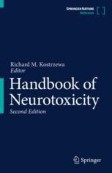Search
Search Results
-
Deferoxamine Prevents Neonatal Posthemorrhagic Hydrocephalus Through Choroid Plexus-Mediated Iron Clearance
Posthemorrhagic hydrocephalus occurs in up to 30% of infants with high-grade intraventricular hemorrhage and is associated with the worst...

-
Sprague Dawley rats from different vendors vary in the modulation of prepulse inhibition of startle (PPI) by dopamine, acetylcholine, and glutamate drugs
RationaleRodent vendors are often utilized interchangeably, assuming that the phenotype of a given strain remains standardized between colonies....

-
Novel Proline Transporter Inhibitor (LQFM215) Presents Antipsychotic Effect in Ketamine Model of Schizophrenia
The glutamatergic hypothesis of schizophrenia suggests a correlation between NMDA receptor hypofunction and negative psychotic symptoms. It has been...

-
Anxiety and cognitive-related effects of Δ 9-tetrahydrocannabinol (THC) are differentially mediated through distinct GSK-3 vs. Akt-mTOR pathways in the nucleus accumbens of male rats
RationaleΔ 9 -tetrahydrocannabinol (THC) is the primary psychoactive compound in cannabis and is responsible for cannabis-related neuropsychiatric...

-
Oleoylethanolamide restores stress-induced prepulse inhibition deficits and modulates inflammatory signaling in a sex-dependent manner
RationaleSocial stress contributes to the development of depressive and anxiety symptomatology and promotes pro-inflammatory signaling in the central...

-
Synaptic mechanisms underlying onset and progression of memory deficits caused by hippocampal and midbrain synucleinopathy
Cognitive deficits, including working memory, and visuospatial deficits are common and debilitating in Parkinson’s disease. α-synucleinopathy in the...

-
GABAergic Abnormalities Associated with Sensorimotor Cortico-striatal Community Structural Deficits in ErbB4 Knockout Mice and First-Episode Treatment-Naïve Patients with Schizophrenia
The current study was designed to explore how disruption of specific molecular circuits in the cerebral cortex may cause sensorimotor...

-
Effect of gabapentin on sleep-deprivation-induced disruption of prepulse inhibition
RationaleThere are controversial reports on the effects of gabapentin in respect to psychotic symptoms. Prepulse inhibition of the acoustic startle...

-
Prepulse Inhibition and Vulnerability to Cocaine Addiction
Prepulse inhibition (PPI) of the startle reflex is the most common sensorimotor gating index, representing the brain’s ability to filter out...
-
Sex-specific effects of psychedelics on prepulse inhibition of startle in 129S6/SvEv mice
BackgroundPrepulse inhibition (PPI) of startle is a sensorimotor gating phenomenon perturbed in a variety of neuropsychiatric conditions....

-
Serotonin 5-HT1B receptor-mediated behavior and binding in mice with the overactive and dysregulated serotonin transporter Ala56 variant
RationaleElevated whole-blood serotonin (5-HT) is a robust biomarker in ~ 30% of patients with autism spectrum disorders, in which repetitive...

-
Consensus Paper: Cerebellum and Reward
Cerebellum is a key-structure for the modulation of motor, cognitive, social and affective functions, contributing to automatic behaviours through...

-
Developmental Manipulation-Induced Changes in Cognitive Functioning
Schizophrenia is a complex neurodevelopmental disorder with as-yet no identified cause. The use of animals has been critical to teasing apart the...
-
Brain endothelial CXCL12 attracts protective natural killer cells during ischemic stroke
BackgroundThe innate lymphoid cell (ILC) family consists of NK cells, ILC type 1, 2, 3 and lymphoid tissue inducer cells. They have been shown to...

-
Exploring Oscillations in Expert Sensorimotor Anticipation: The Tennis Return of Serve
In order to react quickly and precisely, multiple brain areas must interact using optimized mechanisms. Using a particular sports example, the return...
-
A shifting role of thalamocortical connectivity in the emergence of cortical functional organization
The cortical patterning principle has been a long-standing question in neuroscience, yet how this translates to macroscale functional specialization...

-
Psychiatric Disorders in Animal Models of Schizophrenia
Schizophrenia is a devastating mental illness in which characteristic symptoms appear, including “positive” (i.e., hallucinations and delusions),...
-
Dystonia in Childhood: How Insights from Paediatric Research Enrich the Network Theory of Dystonia
Dystonia is now widely accepted as a network disorder, with multiple brain regions and their interconnections playing a potential role in the...
-
Endophenotype trait domains for advancing gene discovery in autism spectrum disorder
Autism spectrum disorder (ASD) is associated with a diverse range of etiological processes, including both genetic and non-genetic causes. For a...

-
Microglial–oligodendrocyte interactions in myelination and neurological function recovery after traumatic brain injury
Differential microglial inflammatory responses play a role in regulation of differentiation and maturation of oligodendrocytes (OLs) in brain white...

